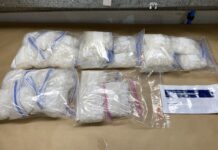By rnz.co.nz and is republished with permission
A quarter of the New Zealand team was not tested ahead of the Paris Games, according to International Testing Agency data.

By enz.co.nz and is republished with permission
Close to 90 percent of athletes worldwide were tested ahead of the 33rd Olympics – but a breakdown of the anti-doping data shows 25 percent of New Zealand athletes were not tested at all.
Twenty-nine percent were tested once and 46 percent were tested frequently.
Of the top 25 nations – based on medal count from the last Olympics – New Zealand had the highest percentage of athletes not tested this year.
Conversely, all athletes from Russia and Belarus, who are competing as individual neutral athletes (AIN in the French translation) due to the war in Ukraine, were tested at least once, with 97 percent tested more frequently.
The International Testing Agency (ITA) table of drug testing ahead of the Paris Olympics. Photo: supplied
Athletes competing in sports considered as high-risk disciplines by the International Testing Agency were under more scrutiny in the lead up to the Games.
Competitors in these 45 identified sports and disciplines were recommended to be tested at least three times during the pre-Games period. Of this group, 95 percent were tested at least once, 75 percent three or more times and less than 5 percent were not subject to any testing.
Every surfer competing in Tahiti was tested frequently as were 98 percent of weightlifters, 97 percent of marathon swimmers and 97 percent of athletes competing in breaking, which is making its Olympic debut.
Chinese swimmers have been in the spotlight this year after it was revealed in April that 23 Chinese swimmers had tested positive for a banned drug before the 2020 Tokyo Olympics.
ITA data up until 22 July showed that 98 percent of China’s 405-strong Olympic contingent had been tested this year.
New Zealand surfer Billy Stairmand was among the New Zealand athletes tested ahead of the Paris Olympics. Photo: PHOTOSPORT
However, 20 percent of Olympic swimmers from around the world arrived to compete at La Defense Arena without being tested.
New Zealand swimmer Lewis Clareburt, who is competing in three events at his second Olympics told RNZ “you can never have full confidence” that Olympic swimming would be clean.
“Especially after the news that has been coming out over the last six months, but all you can do as an athlete is do your best and make sure that you’re clean and you just hope that the people that are testing and are in charge of keeping sport safe are doing their job and that’s all we can do.”
ITA director general Benjamin Cohen said the anti-doping programme his organisation ran ahead of the Paris Olympics “is the most robust pre-Games programme ever implemented for an edition of the Olympic Games”.
“Pre-Games testing is not only key when it comes to risk and anti-doping strategies, it also aims at giving athletes and fans confidence in a clean Olympic Games.”
Photo: Supplied / Drug Detection Agency
Cohen said the Pre-Games testing project had “highlighted some gaps, limitations and areas for improvement that we need to address immediately if we are to continue to raise the bar for all athletes who train so hard and want fair and clean competitions”.
However, a day after the ITA released the data on the anti-doping programme in Paris, the organisation was reporting an out-of-competition doping violation by Iraqi judoka Sajjad Ghanim Sehen Sehen.
A sample collected from the athlete returned an adverse analytical finding for an anabolic androgenic steroid on the World Anti-Doping Agency prohibited list.
Sehen Sehen has been provisionally suspended, meaning he is prevented from competing, training, coaching, or participating in any activity during the 2024 Olympics.










